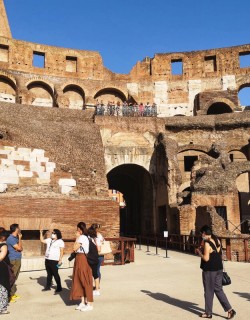If the Borghese Museum looks more like a summer mansion for the impossibly chic and wealthy than it does a museum—it is because it is. Or it was, at least. The House of Borghese was one of the prominent noble families in Italy, making a name for itself in the fourteenth century Sienna and later moving to Rome. But it was the 1600s when the Borghese family really made their mark. Mr. Camillo Borghese got himself a free room at the Vatican and changed his name to Pope Paul V. With his new powers, Paul Five showed his little nephew Scipione Borghese some papal love and made little Scipione cardinal. And here is how we arrive at the Villa Borghese Gardens and one of the most jaw-dropping collections of art in the history of the world.
Cardinal Scipione hired some guys to build a little villa with English gardens and a pond and a zoo and a party house on his 148-acre plot of land in Rome. Little did he imagine his getaway mansion would turn into a hotspot museum, flooding with tourists. Group tours in Rome wasn’t what Cardinal Borghese had in mind. Being a patron of the arts, Cardinal Borghese patronized and often threated any little church or patron of the arts that had a painting he liked. In one famous instance, the Papal Borghese Boys had gotten word that Caravaggio’s old pal d’Arpino hadn’t paid his taxes. In lieu of paying the taxes, over one hundred paintings in d’Arpino’s possession were confiscated, including two of Caravaggio’s most famous early works—Boy with a Basket of Fruit and Sick Bacchus.
By means of influence and money, Cardinal Scipione’s collection grew to include the likes of Raphael and Titian and Domenichino, making the Borghese name equally as important to the world of baroque art history as it was to the Catholic Church. The list of paintings and sculptures the cardinal acquired is proverbially endless, however one of the most notable of Scipione’s effects on the Italian art world was his relationship with Gian Lorenzo Bernini. The Borghese Museum holds some of Bernini’s most praised sculptures. From David (as in David and Goliath) who looks more like an Olympian tossing a discus in mid-spin than an adolescent rascal with a slingshot to Bernini’s dendrophiliac-in-motion depiction of Apollo and Daphne. Besides being responsible for decorating the greater part of the Eternal City, Bernini was also responsible for bringing the ironic sensation of motion to the art of sculpture. However it was Cardinal Borghese that was responsible for putting Bernini into motion. He was Bernini’s first major patron, contracting him to line his new mansion (a.k.a. the Borghese Museum) with several sculptures depicting ancient myths, plus a nice papal bust of himself. Bernini actually made two busts after accidentally cracking Scipione’s face on his first attempt. He gifted the cardinal the cracked version as a joke, later presenting him with the final product.
With two busts of himself, two floors of the art world’s most highly touted baroque masterpieces and an almost infinite pool of money, the Villa Borghese was now the ultimate party house. Though it is no longer used for weird seventeenth century-style ragers, the Villa is still a much visited getaway from the city while never leaving the city, which is about all you can ask for being in Rome.
– By Tony Mastroianni –


